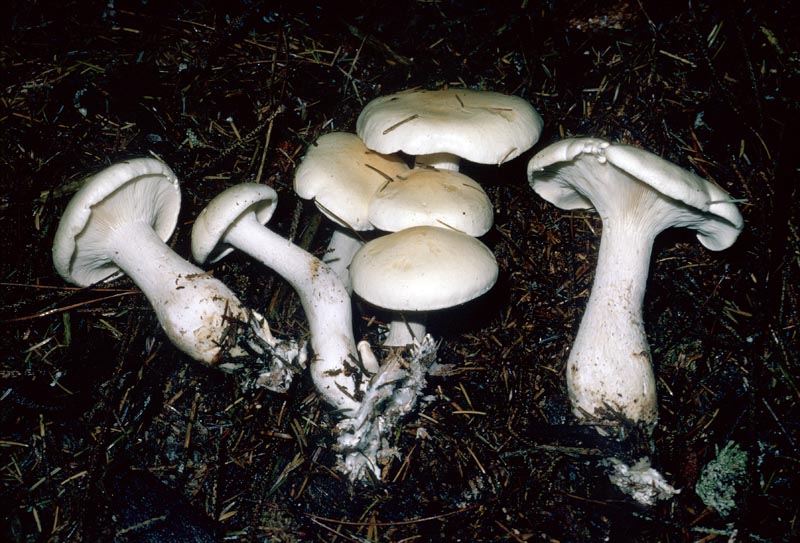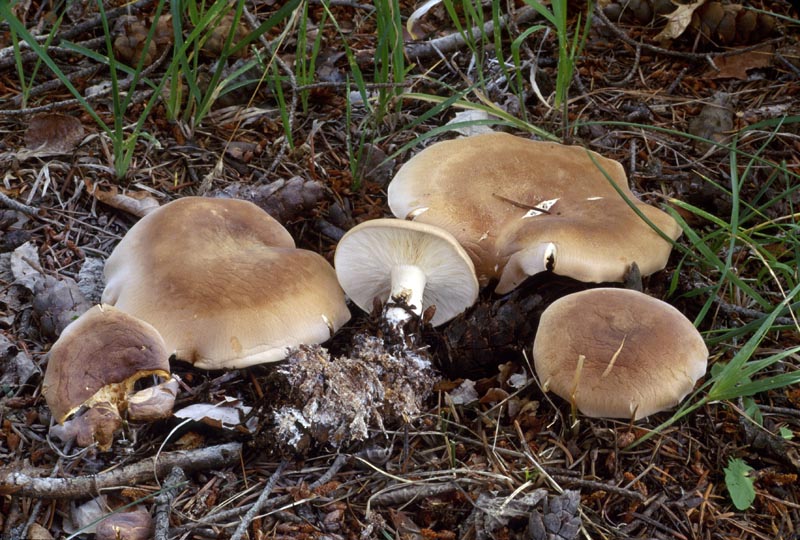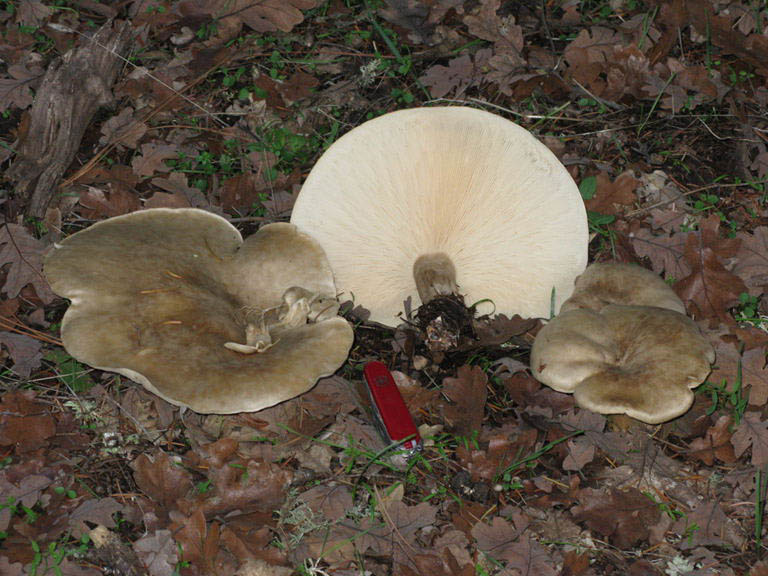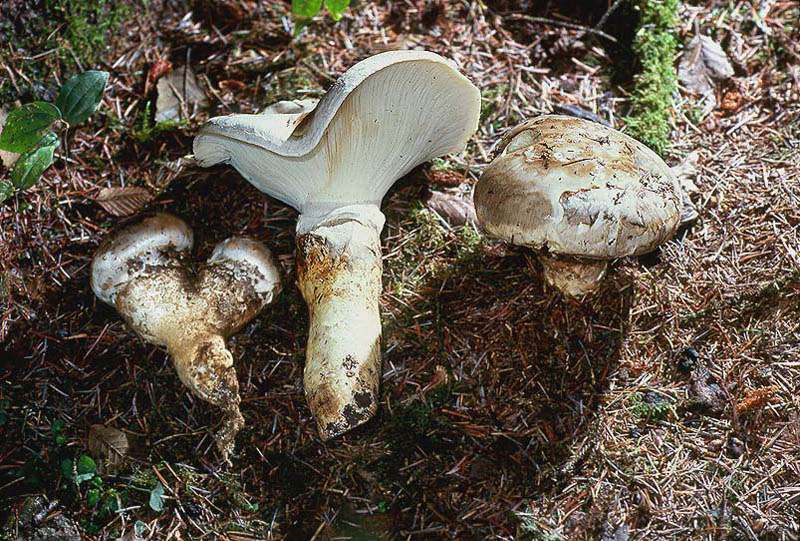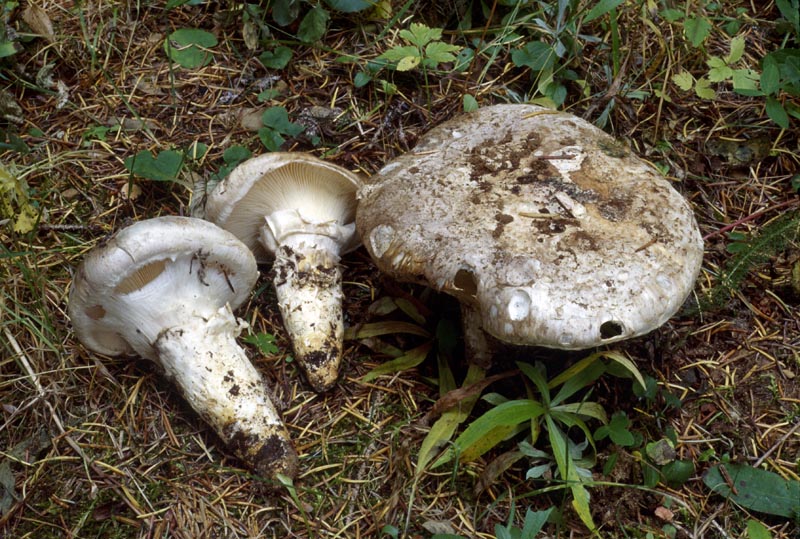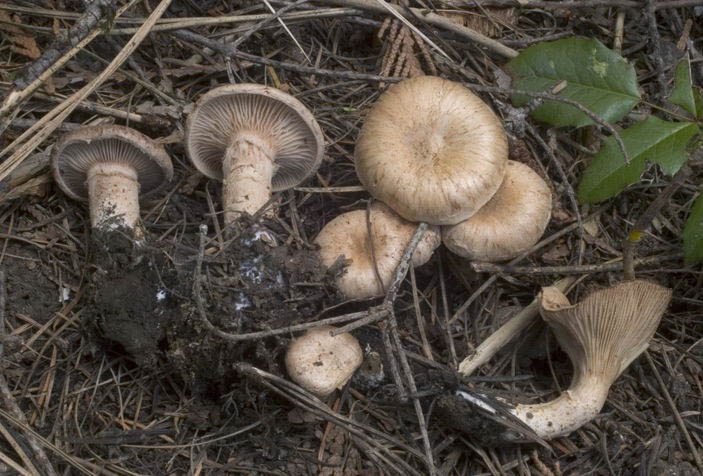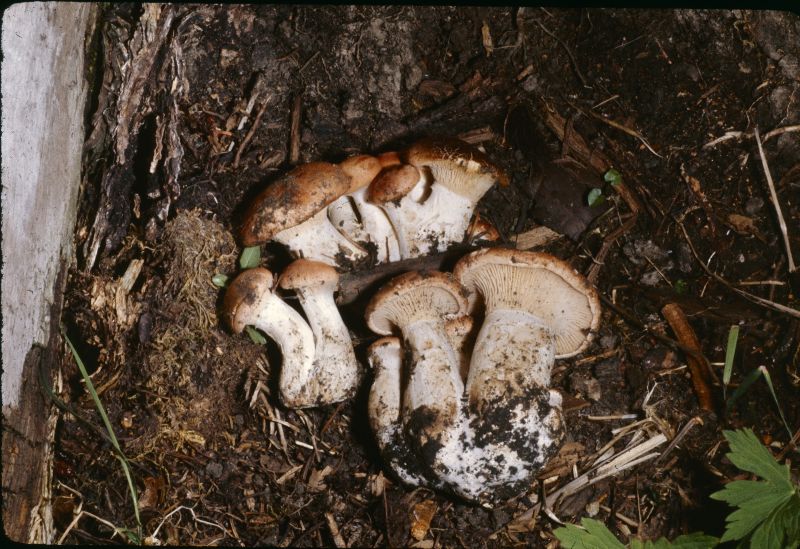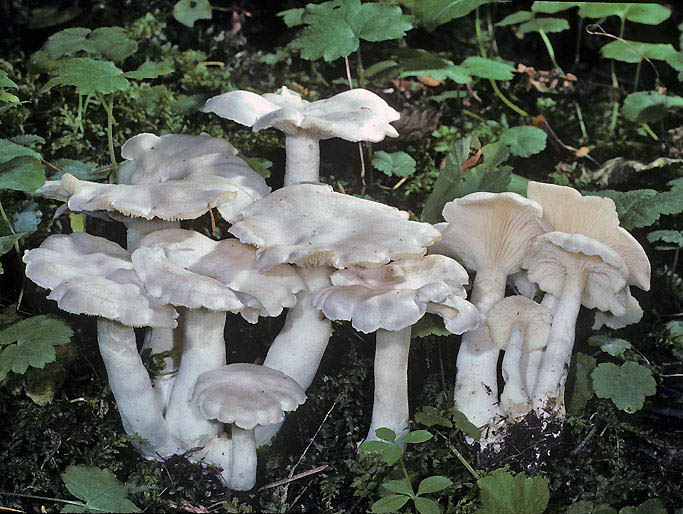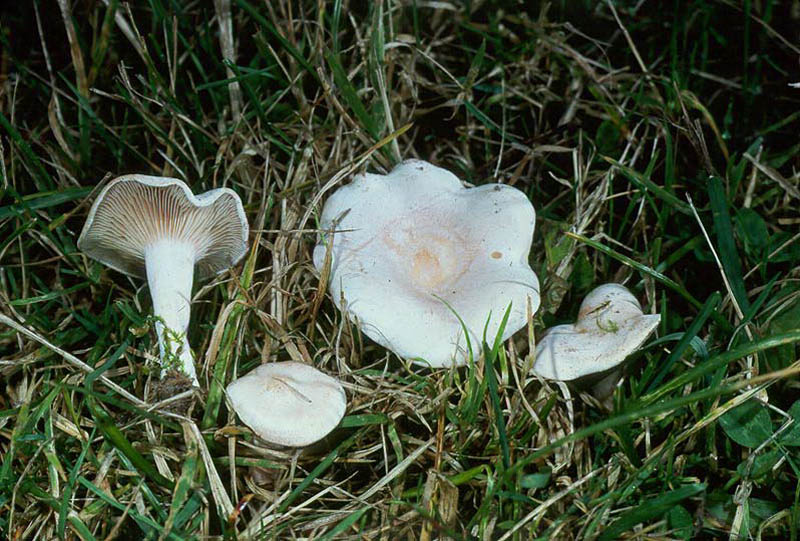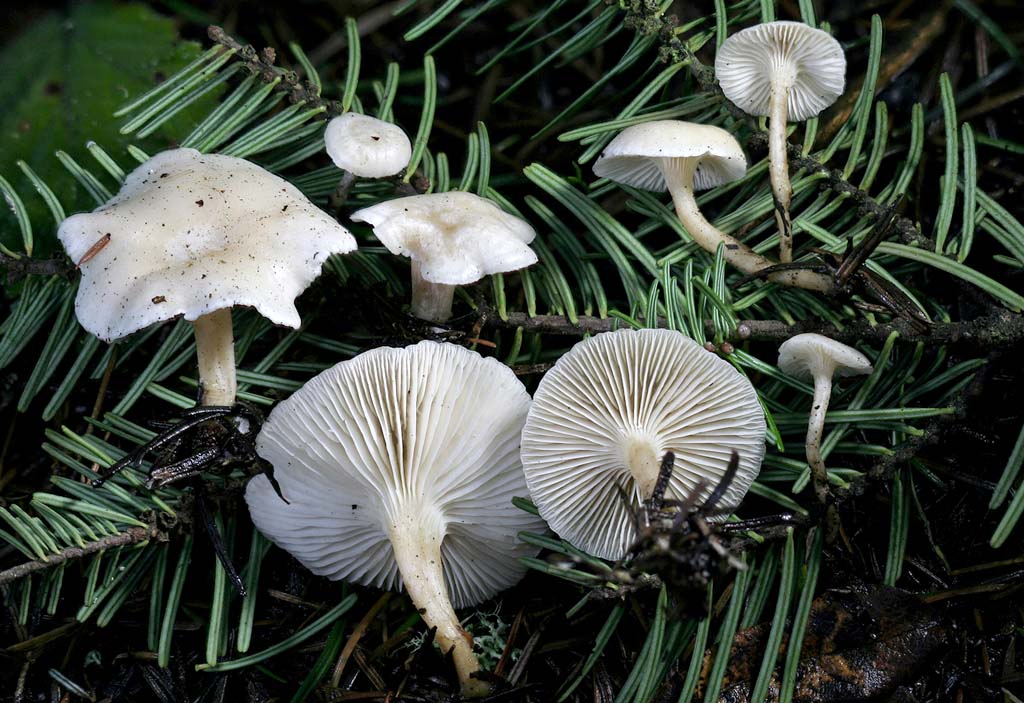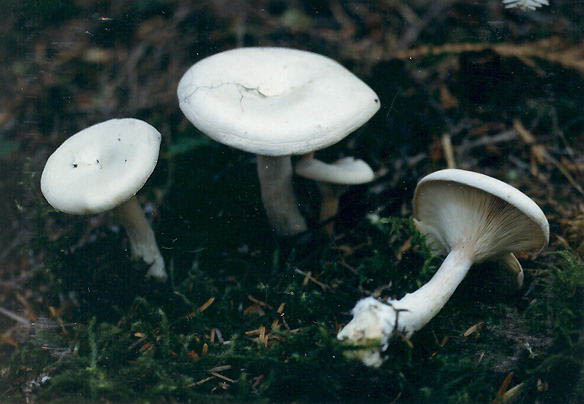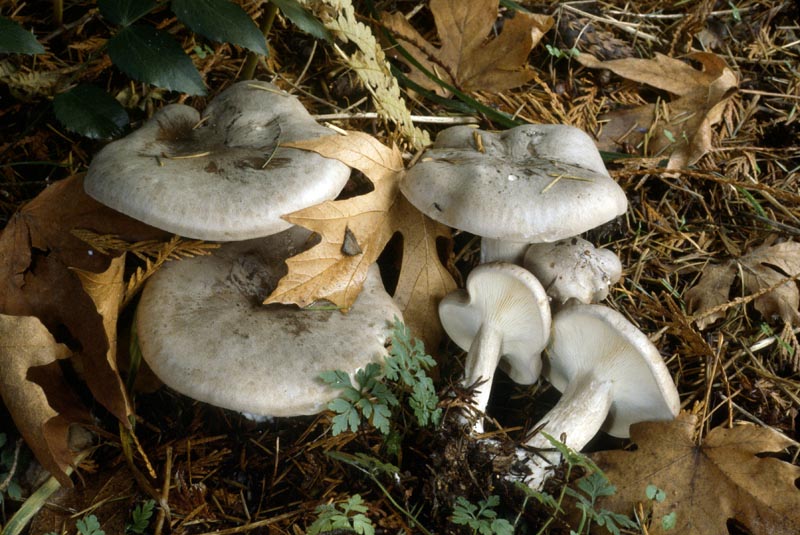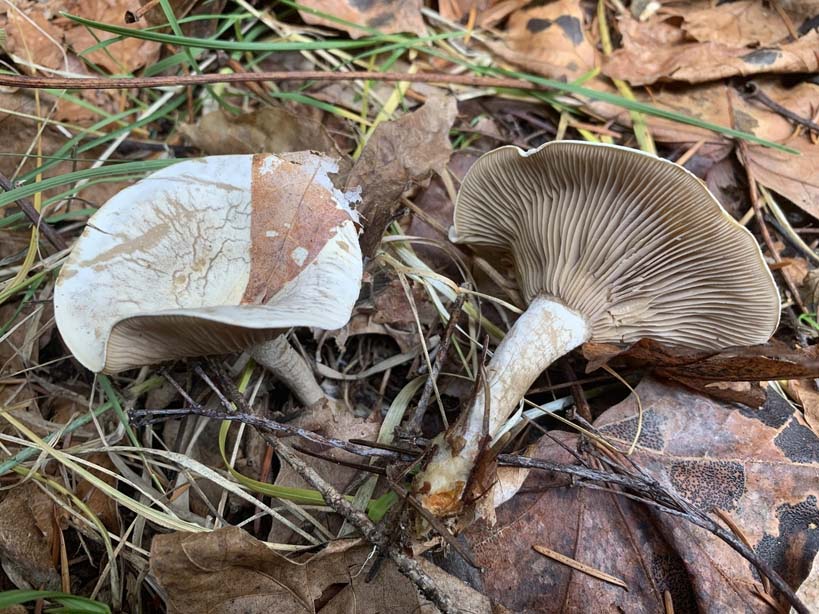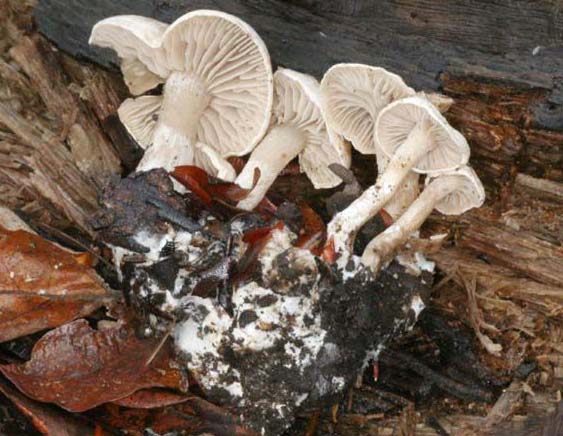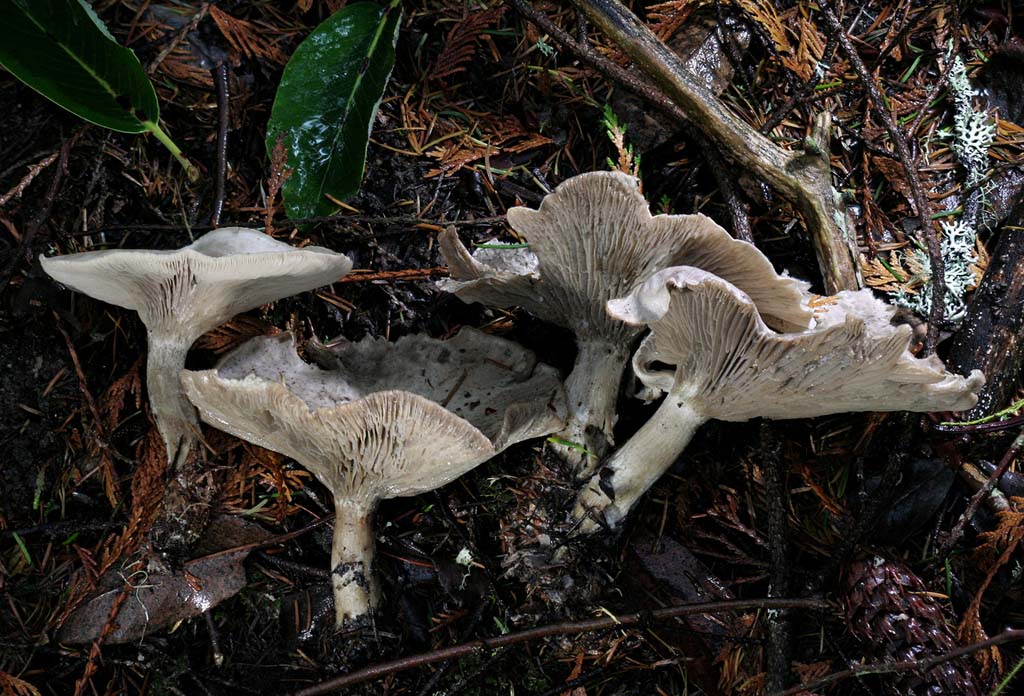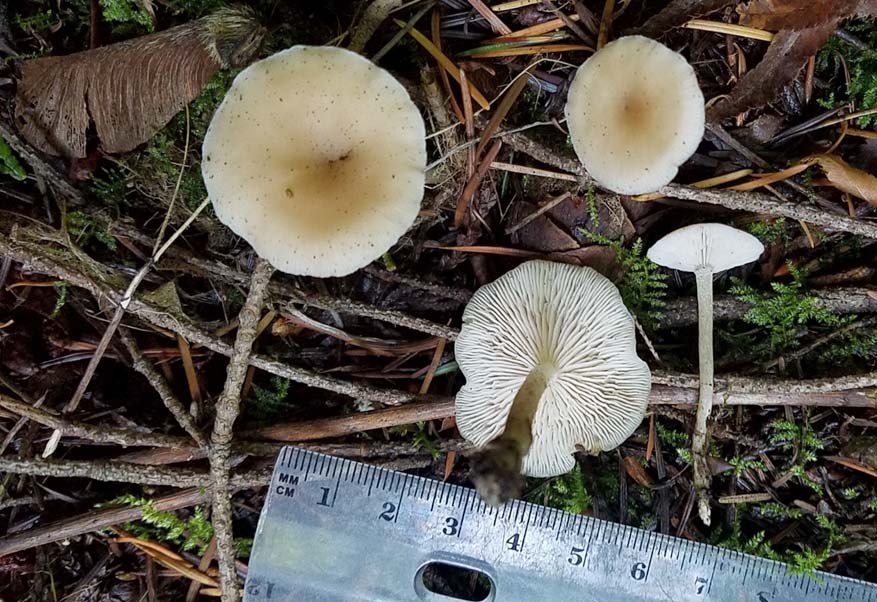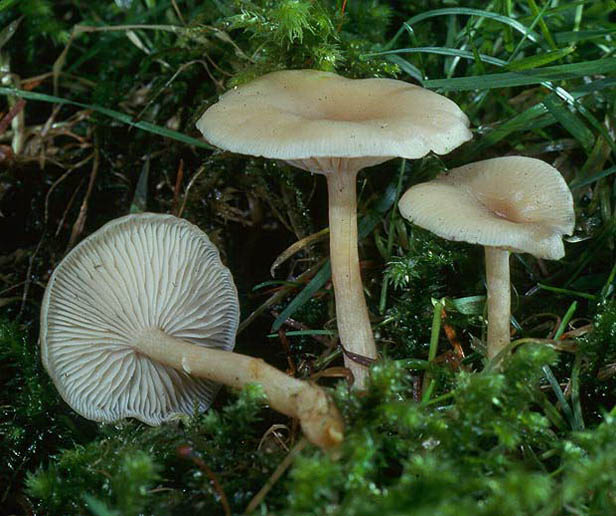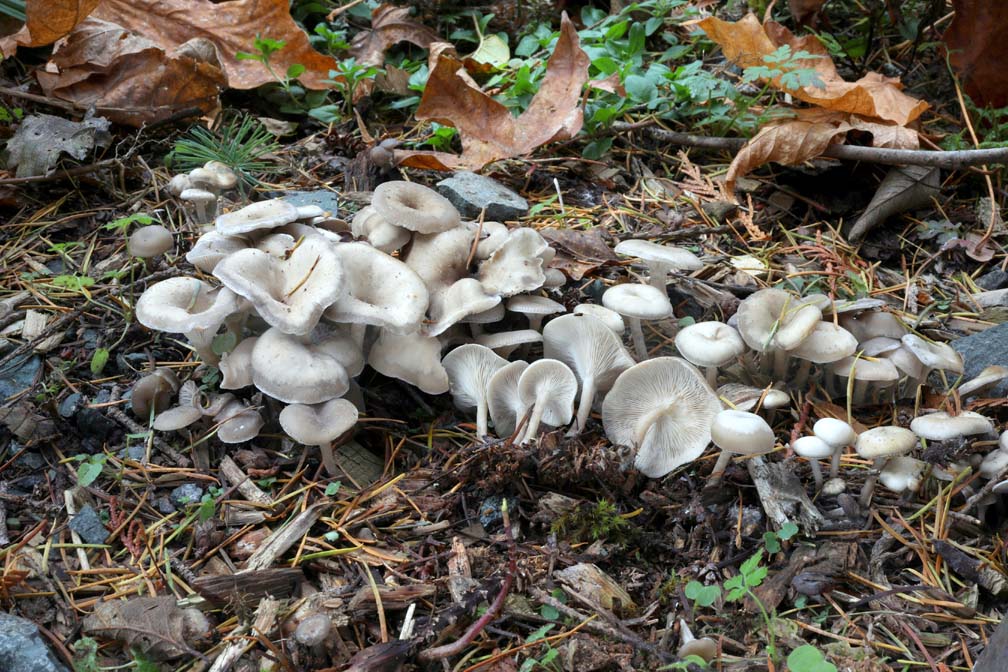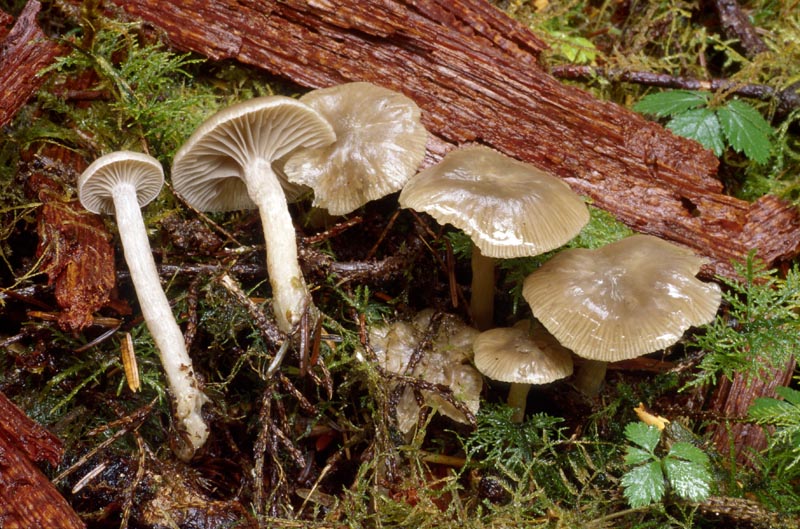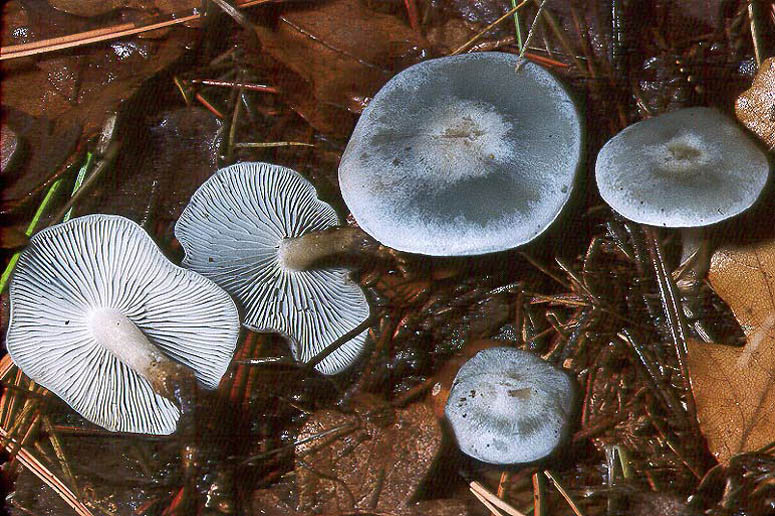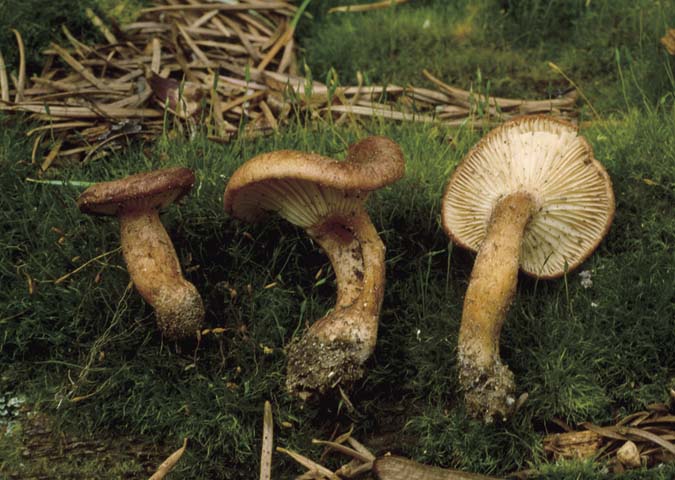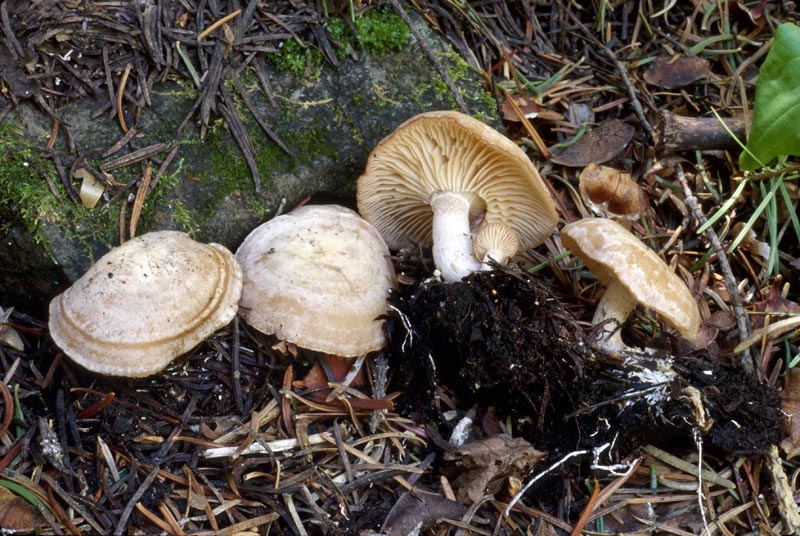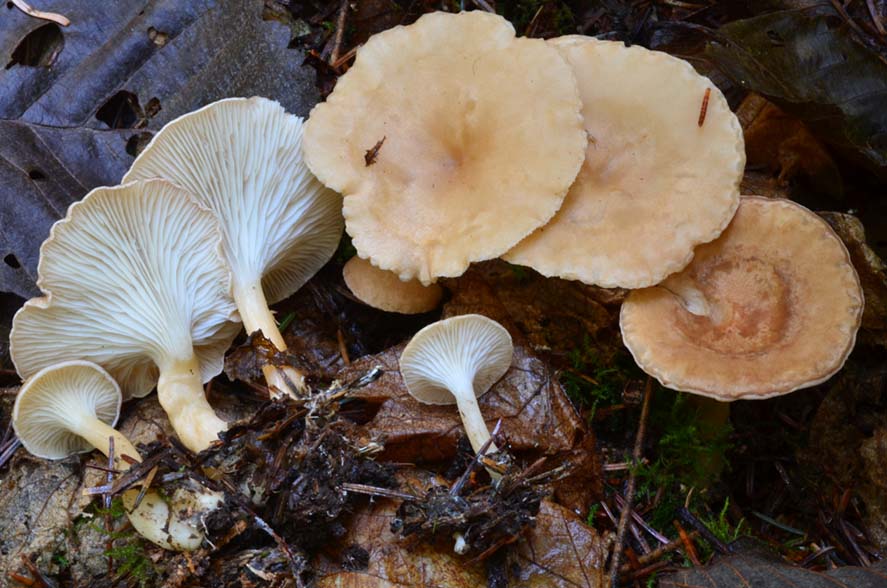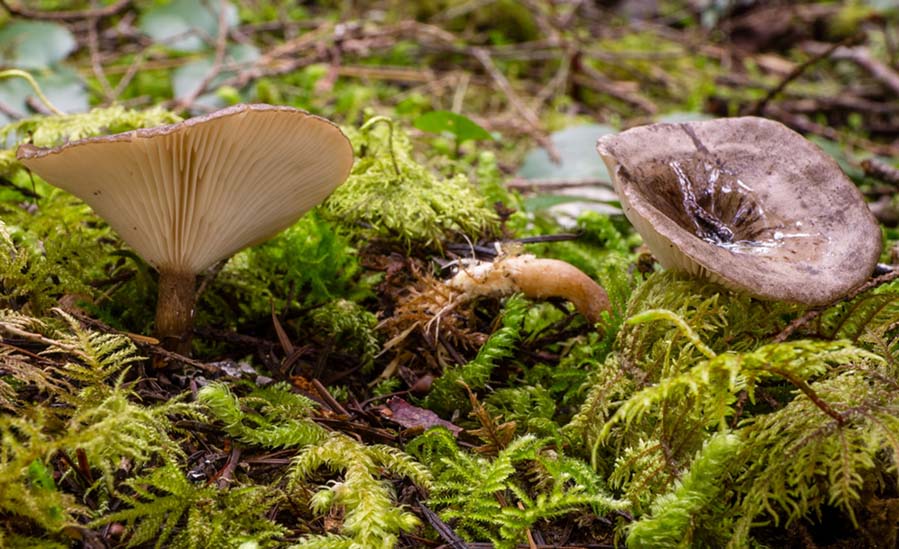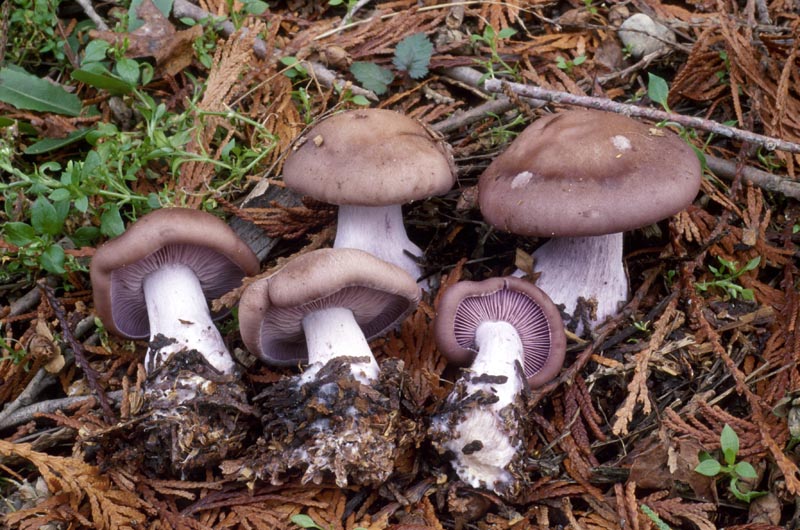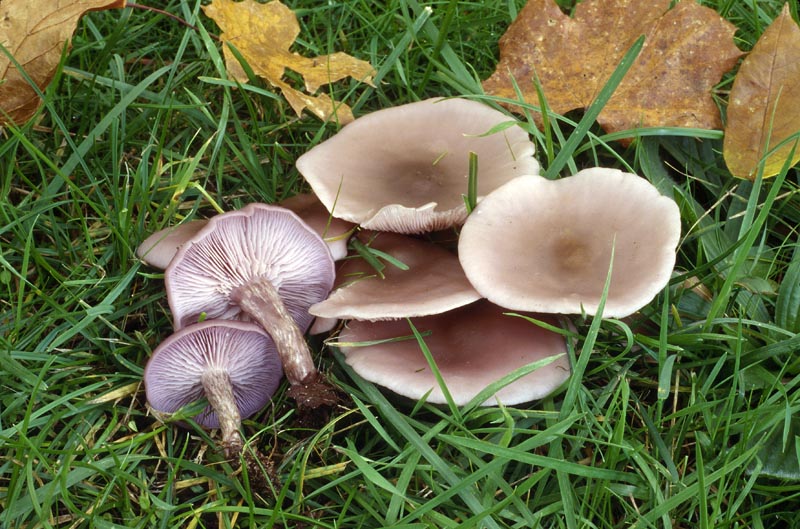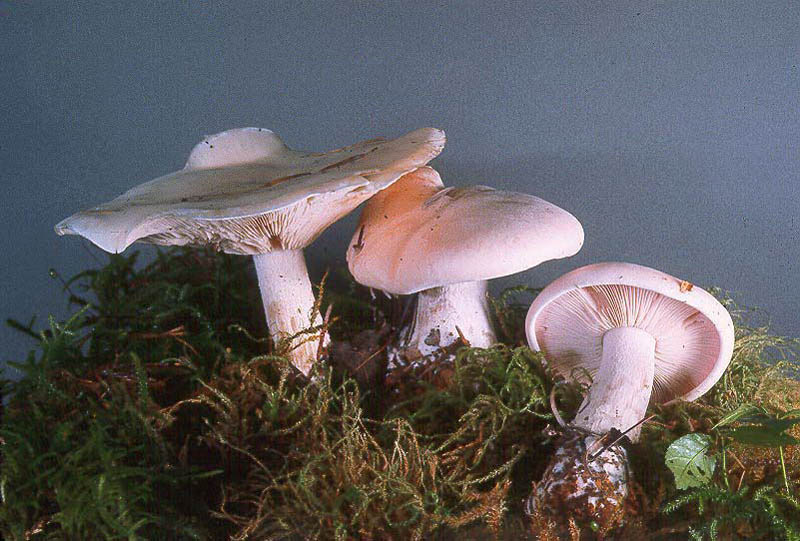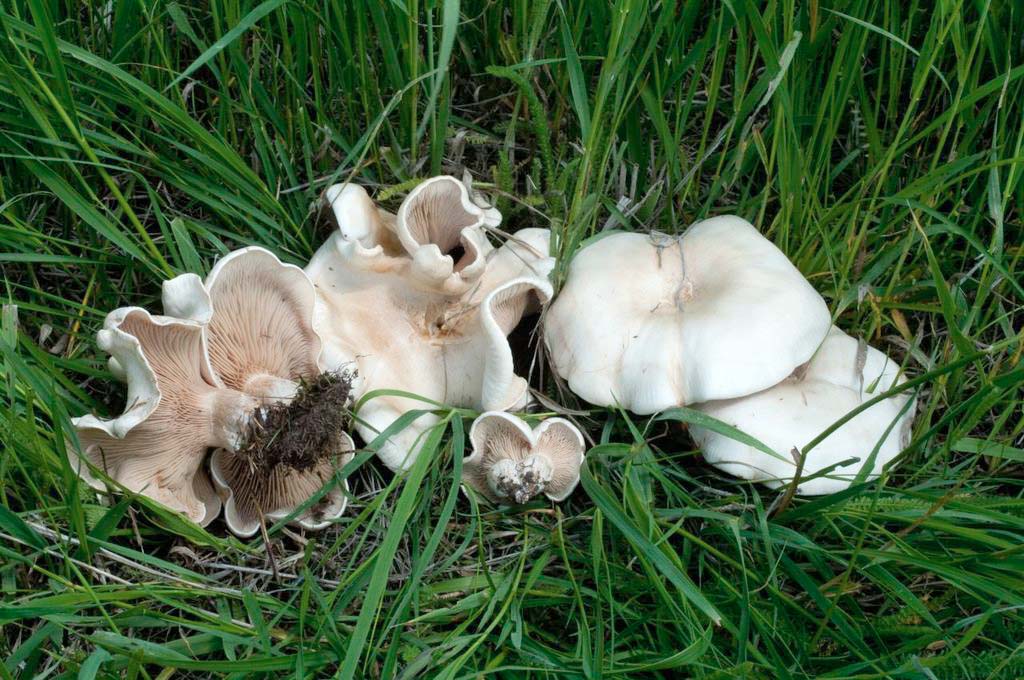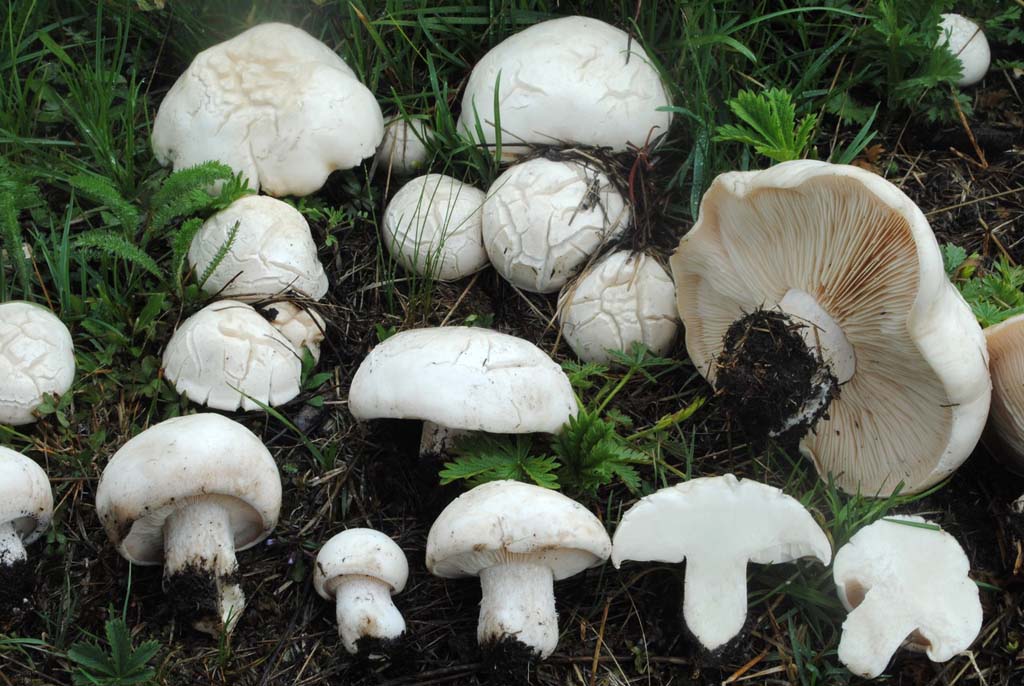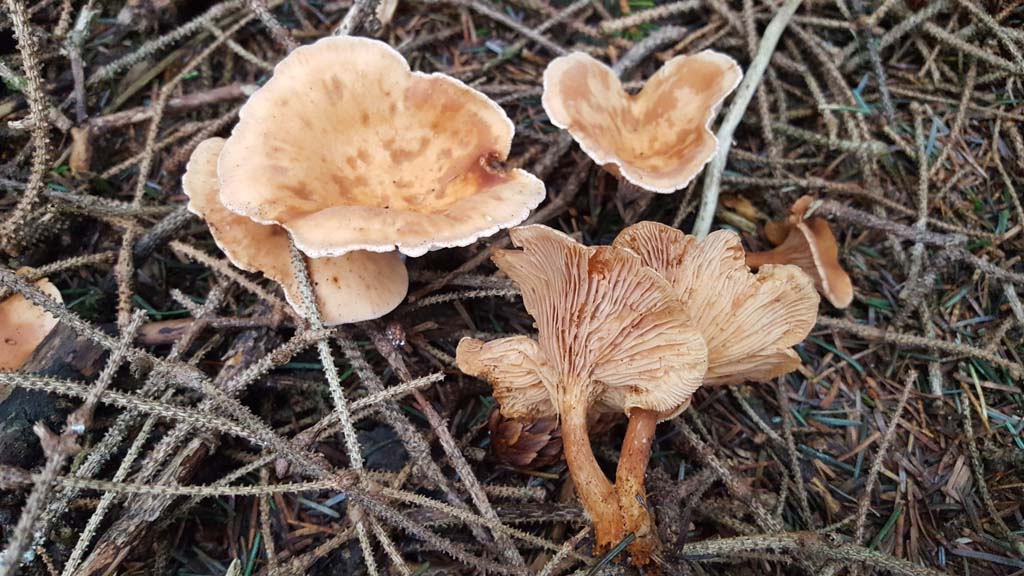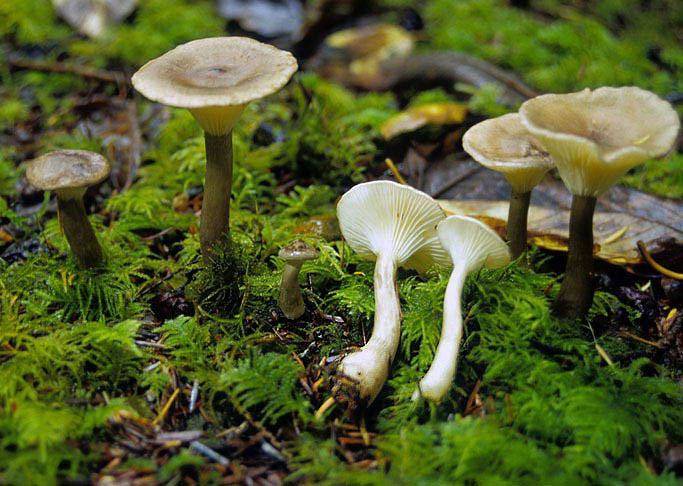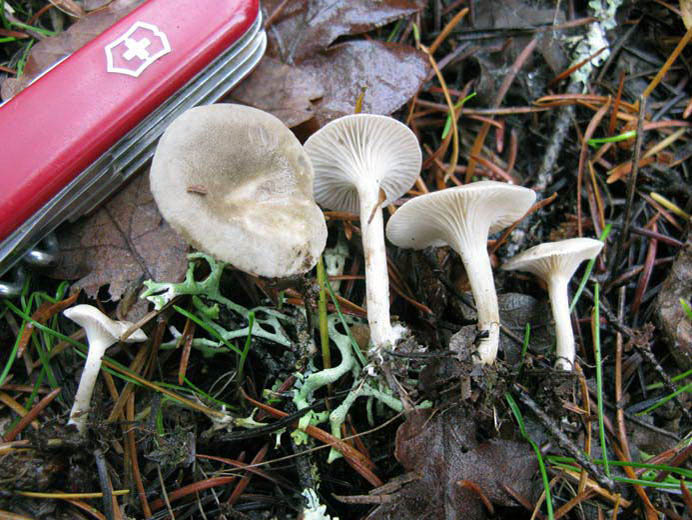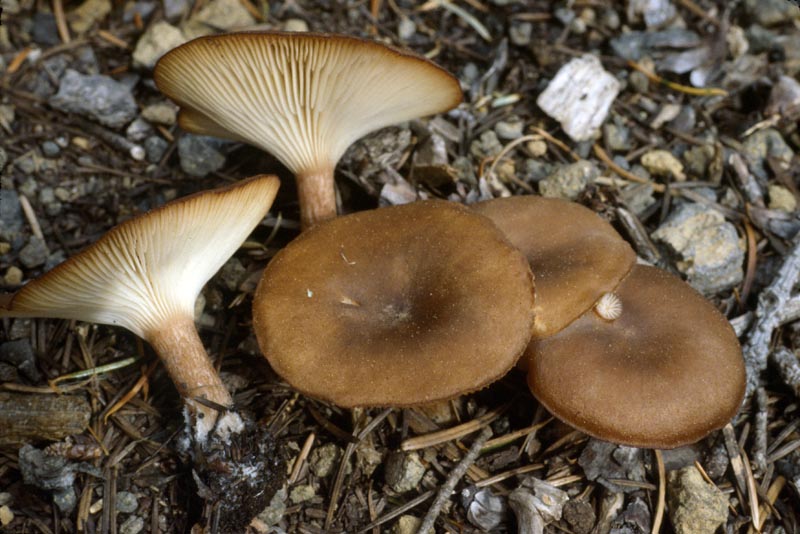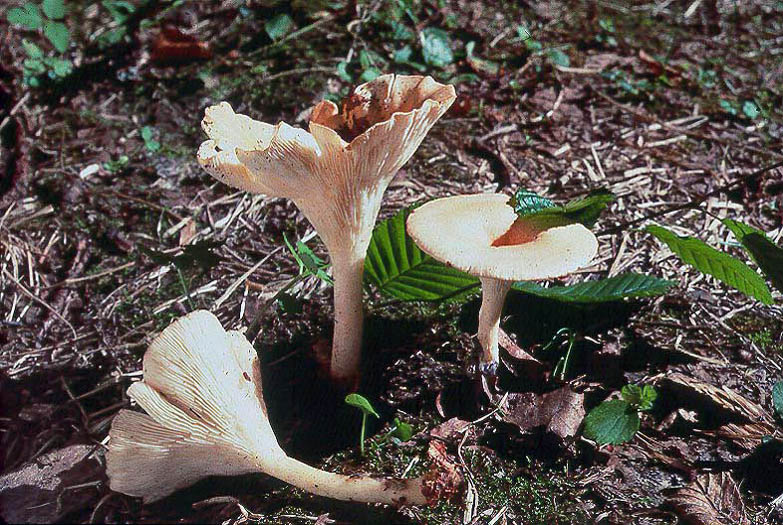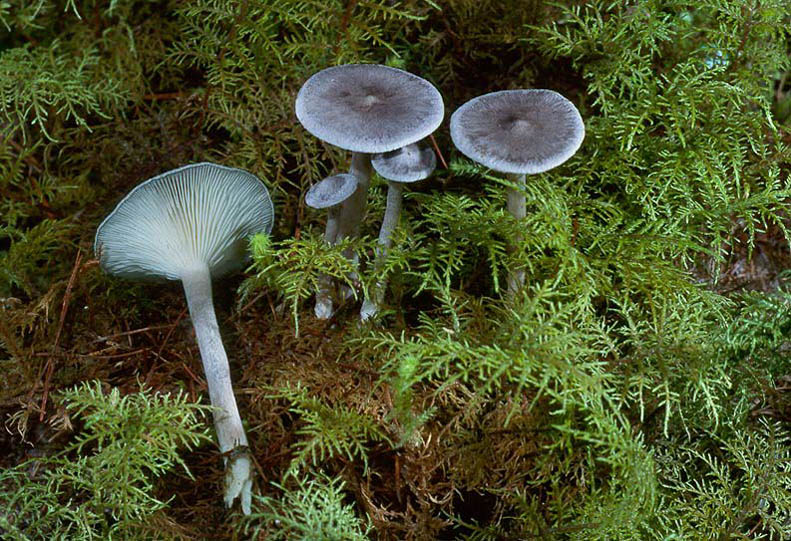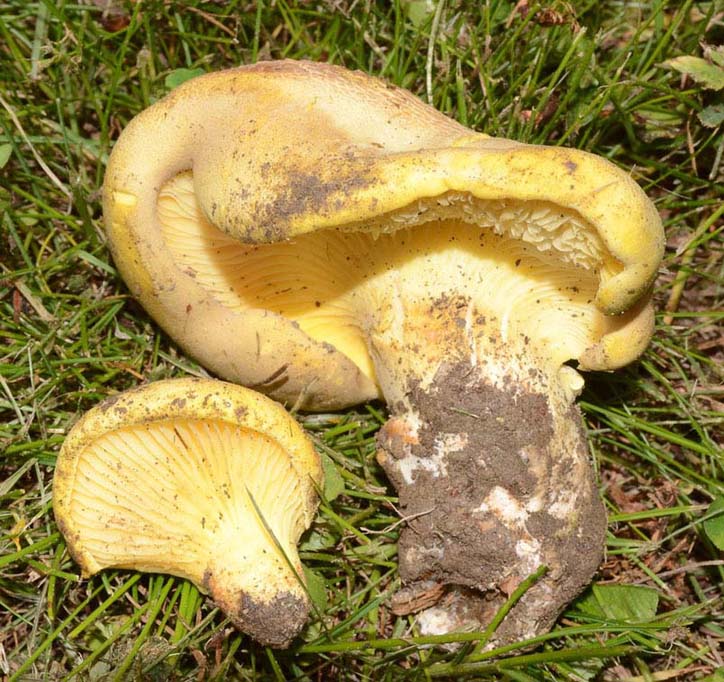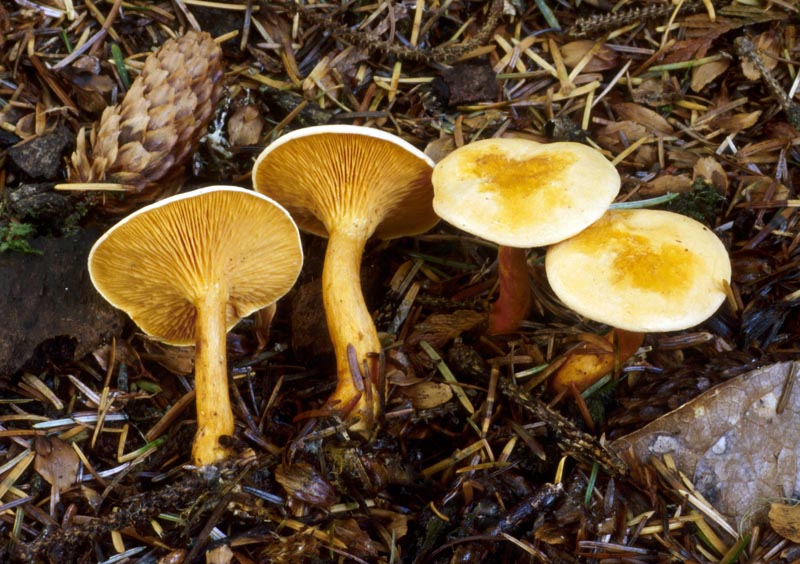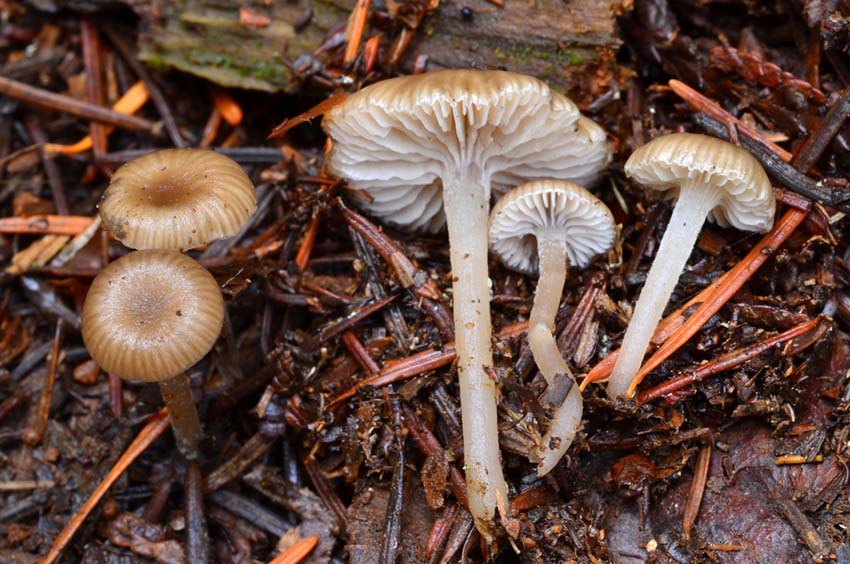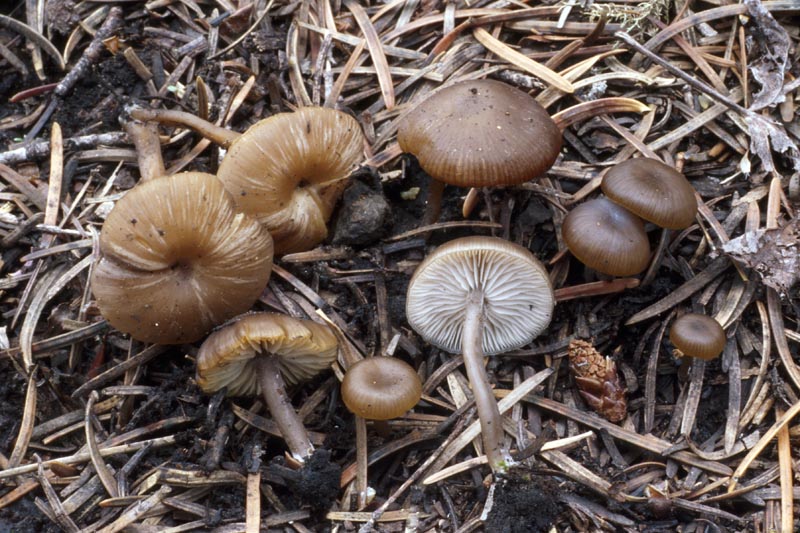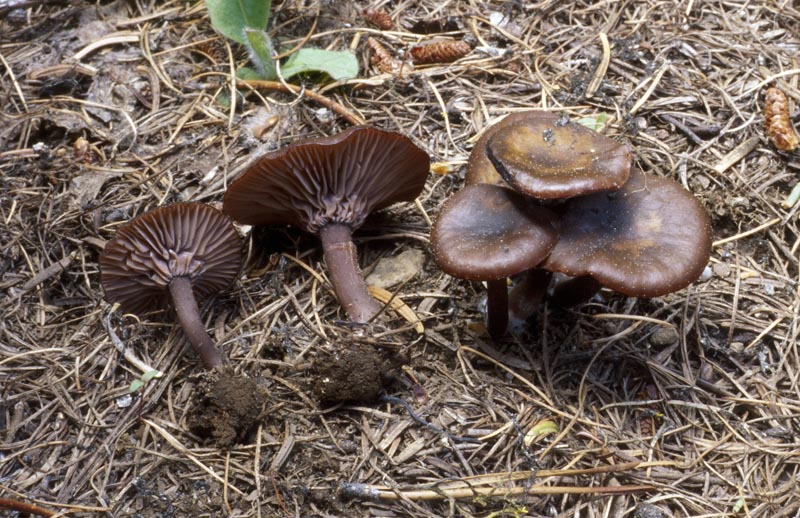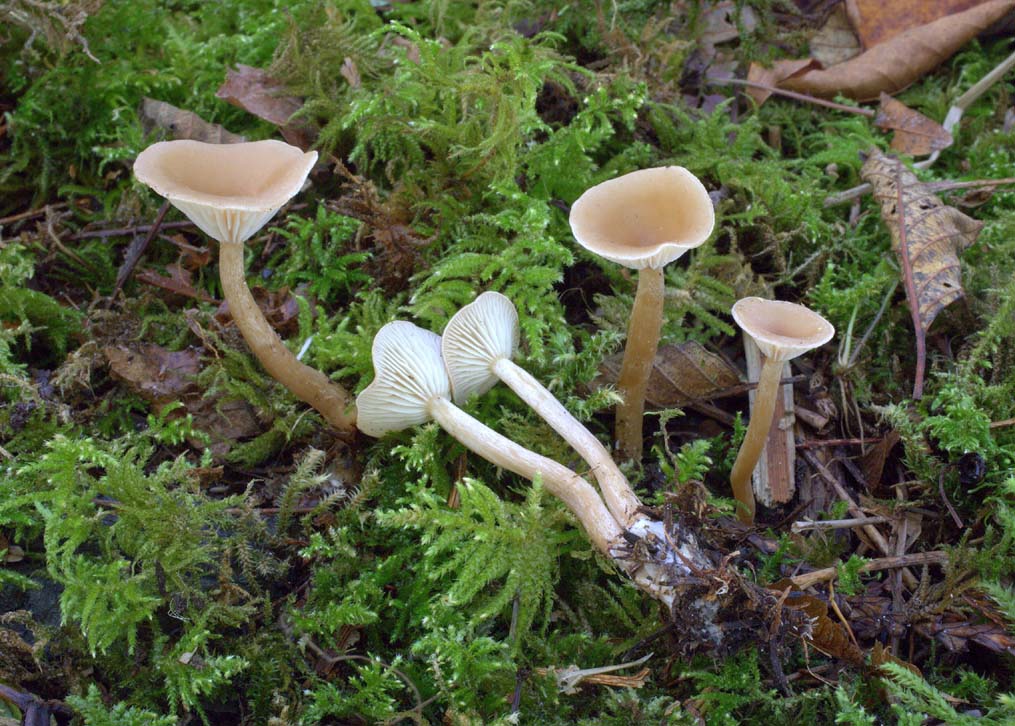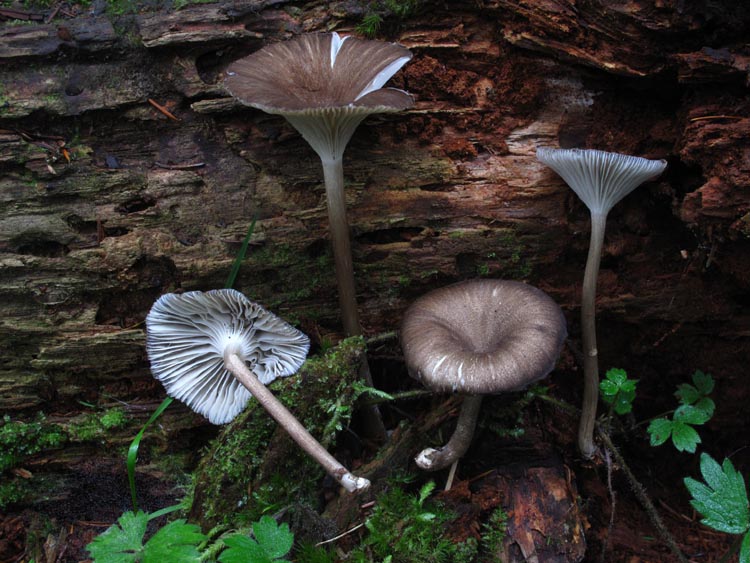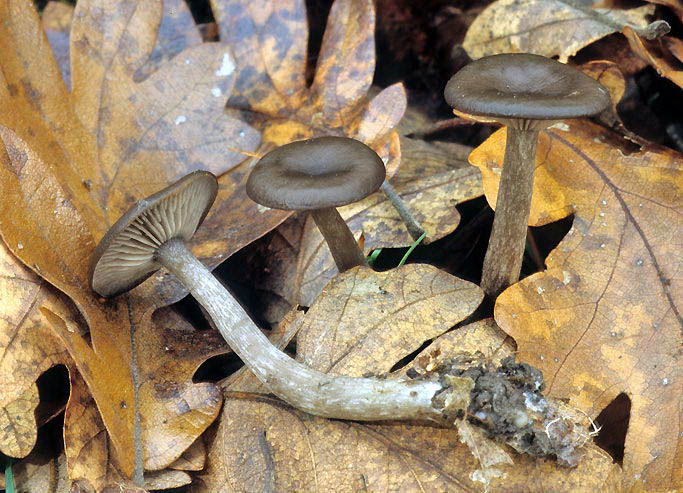Clitocyboid
They are mostly found on the ground, although they are often saprophytic and members
of the Tricholomatoid clade unless otherwise
specified. Not
hygrophanous
unless noted.
| The very brightly orange gilled Hygrophoropsis is
actually a gilled bolete. |
| Hohenbuehelia petaloides, a
shoehorn shaped oyster, usually grows on the ground with an
eccentric stem. Learn to recognize it. |
| Melanoleuca and
Lyophyllum (and
Tephrocybe) may occasionally have
decurrent gills, but that is not typical so they are found under "collybioid". |
| The pink-spored
Rhodocybe sometimes has pale pink spores, enough to confuse it with Lepista
(covered here) or even Clitocybe. It doesn't help that the characteristic
angular spores of the Entolomataceae are less pronounced in Rhodocybe as well. |
| Some small colourful mushrooms may be
waxy cap relatives, especially if
they're on wood. Pseudoomphalina
and other omphalinoid mushrooms
can also be large enough to be confused with Clitocybe. |
- Leucopaxillus/Aspropaxillus -
gills easily removable. Either very dense large
fruitbodies that would rather bounce than break (Leucopaxillus) or a
fragile, very large (up to 40cm!) species (Aspropaxillus). No partial veil.
- Catathelasma - very pale, large, dense
fruitbodies with a dual partial veil, resembling a large
Matsutake.
- Cleistocybe - the only other genus
with a partial veil, regular size.
- None of the above - Sorry, but the bulk of this category is difficult to characterize and you are
going to have to browse.
Leucopaxillus/Aspropaxillus - large
mushrooms with easily removable gills that resemble Clitocybe but
may be much
tougher. Throw a clitocyboid mushroom at your friend's head and if it
bounces off good as new it may be a Leucopaxillus. Aspropaxillus
is one of our largest gilled mushrooms (up to 40 cm!) but not as dense.
Microscopically, Leucopaxillus has amyloid warty spores (they darken in iodine)
and Aspropaxillus has amyloid smooth spores. These all smell somewhat distinctive, usually
farinaceous to some degree.
Leucopaxillus are some of the only mycorrhizal mushrooms on this
page, which probably makes them some of Tricholoma's closest relatives.
Leucopaxillus albissimus grp - <20cm, mostly white,
strongly decurrent gills, taste often
unpleasant or bitter.
Leucopaxillus gentianeus grp ('amarus') - <15cm, brown cap,
definitely bitter. Gills adnate.
Aspropaxillus septentrionalis - pale tan
to grey, up to 40cm!
C. maxima and I. geotropa may also get
very large. Unpleasant odor and taste.
Catathelasma - Very large mushrooms (up to 40cm!) with
decurrent
gills separated from Clitocybe by their double partial
veil. Farinaceous.
They are also mycorrhizal. Amyloid spores (darkening in iodine). It is difficult
to tell these two apart, and our local species is probably neither of the below
but something new.
C. singeri ('imperiale') - said to be the largest, most viscid cap and
perhaps
darker.
C. ventricosum - still very large, perhaps paler, dryer capped.
Cleistocybe - the only other genus with a partial veil, not
nearly as large.
Cleistocybe vernalis - Much like a
Clitocybe with a
veil, which is pretty much
what it is. Tricholomatineae. Dry felty cap around 5cm. Fruits in the
spring.
'Cleistocybe' gomphidiodes - maybe only a hint of a partial veil,
viscid
red-brown cap, gills grey in age. Fall.
Clitocybe s.l. - there are a large
number of Clitocybes that look similar. There are
always specimens coming in during forays that can't be easily identified to
species, so there is a chance that your Clitocybe won't be found here. The genus
is not well understood in the PNW. Some have been found to be quite poisonous.
The smallest species have caps <5cm with stems <5mm
thick. Stocky species may grow to have caps >10cm. Their stems
will often be >1cm thick.
First, the whitish to greyish species, often covered in a white chalky
pruina if you catch them in the right conditions, but usually neither
hygrophanous nor striate. Some are easily confused with
the pale Lepistas, which are never chalky.
C. glacialis - <8cm,
snowbank, starts chalky white, becomes dark and greasy!
Leucocybe connata ('Clitocybe dilatata') - <15cm, stocky
or slender, wavy margin, clustered
on roadsides,
chalky white. Resembles Lyophyllum and Lepista densifolia.
Long mistakenly called Clitocybe dilatata.
C. 'rivulosa' ('dealbata') - small (<5cm), white, chalky, in grass.
These species are smaller than L. densifolia.
Leucocybe candicans - similar, in forests under
hardwoods/conifers with a tinge of yellow/grey to the cap.
C. phyllophila group - a large number of similar species in
Clitocybe don't have good names or descriptions yet.
C. nebularis - <25cm, large, grey, stinks like a
skunk!
Atractosporocbye inornata - medium, chalky cap, grey cap and gills, cylindrical spores.
Stem may darken.
Atractosporocybe sclerotoidea - (needs to be renamed from
Clitocybe) - <5cm
yet stocky chalky greyish white parasite on a white sclerotium mass of
Helvella vespertina. May have notched
gills.
Harmajaea harperi - A large, chalky-grey funnel cap that may be felty with a sometimes disagreeable odor and taste and greying flesh
Next,
watery brownish, hygrophanous species, usually striate when wet, with or without an odor.
Leucocybe salmonilamella - (needs to be moved from Clitocybe). A pink tinge to the gills and usually a
pale rim.
C. deceptiva - <5cm, pale greyish-tan watery
hygrophanous look. Smells like black licorice! Pale
pink/white spores.
C. brunneoceracea - sometimes clustered.
C. subditopoda/vibecina/metachroi/diatreta group - <5cm, grey-brown watery hygrophanous.
Some are farinaceous. Which species are here (or how many) is not known
yet, but it's a lot.
Other interesting Clitocybes:
C. odora - <10cm, a greenish-blue
mushroom! Smells and tastes like black licorice. Blue can fade. Rarely
grows waxy with unpleasant odor and then goes by the name
Hygrophorus caeruleus.
Rhizocybe albirhiza - (needs to be renamed from Clitocybe) <10cm fading orange/white
concentric zones. Rhizomorphs (thick
mycelium) on stem
base. Spring, bitter.
Rhizocybe vermicularis subsp americana - spring, darker orange and
more funnel shaped than R. albirhiza. Mild. See also
I. squamosa and L.
subalpina.
Rhizocybe (Clitocybe) rhizoides - similarly odorless with many
rhizomes but dark brown in colour. Found here once in spring at
Mt. Rainier.
Lepista - the primary features of
Lepista are microscopic, a slightly coloured spore print and subtly warty
spores. Half of them are larger and stockier than the average Clitocybe
and more on the adnate side than decurrent, but the other half very much
resemble Clitocybe. This group includes the famous "Blewit", so-called
because it looks like a blue hat, L. nuda. It is probably not correct to
separate these species as a separate genus, since at least 3 clades of
Lepista appear inside Clitocybe, but since the Clitocybe section is already
so big, I am going to do it anyway.
L. nuda group - <15cm, stocky, purple when young, said to
smell like Tang. Many Cortinarius look similar!
L. sordida (tarda) - <10cm, similar colours, but
slender. Purple can fade! Hygrophanous.
L. glaucocana - <15cm, stocky, a uniform
pale pink/lilac. Unpleasantly farinaceous.
L. luscina (subconnexa) - <30cm, large off-white,
in dry grass or sagebrush, variable odor.
L. brunneocephala - very similar, like a purple-less blewitt.
Paralepista gilva - <10cm. orange, funnel
shaped! May have a spicy odor. Hygrophanous.
I. 'gibba' is paler pinkish-orange.
Ampulloclitocybe - two
similar mushrooms in the Hygrophoraceae clade have evolved to very much resemble
Clitocybe. They have grey or brown slightly umbonate (yet depressed in age)
caps, strongly decurrent white gills and inamyloid spores. They
somewhat resemble Pseudoclitocybe (without the umbo
and with amyloid spores) and Cantharellula (with forking
gills that stain red and amyloid spores).
A. 'clavipes' - <10cm, somewhat bulbous stem base,
often with a grape
bubble gum smell!
A. avellaneialba - <10cm but sometimes much
bigger. Not as bulbous, no odor, and perhaps darker
with a slightly ribbed cap margin.
May be found on or near rotting wood.
Spodocybe - small felty grey capped clitocyboids in the Hygrophoraceae.
Spodocybe 'trulliformis' group - <5cm, grey, felty!
Hygrophoraceae.
Clitocybe senilis
- only slightly felty.
Infundibulicybe - strongly funnel shaped in the Tricholomatoid clade but outside of
Clitocybe. Not all of them have formally been moved yet, but
they likely will be.
I. squamulosa group - <8cm, both species can be either bright orange
or dark
brown. Spring, slightly scaly cap centre.
C. mitis - related?, darker, red-brown cap, spring.
C. coacta - similar looking, hygrophanous.
I. 'gibba' - <8cm, pinkish orange, very funnel
shaped! Slender. Lepista inversa is more orange.
C. alnicola - similar, farinaceous taste and
cartilaginous cap cuticle.
'Clitocybe' maxima - stocky variety of I. 'gibba' up to 20cm or more, stocky, usually
orangish. Leucopaxillus giganteus is even bigger but greyer.
I. geotropa - very similar but slight umbo, paler
with less colour. Leucopaxillus giganteus has no umbo
and easily removable gills.
Other miscellaneous genera:
Cantharellula umbonata - <5cm, grey
or brown, gills that fork and flesh that can stain red.
Sharp
umbo in the centre of the
cap. Amyloid spores. Hygrophoraceae.
Cantharocybe gruberi - pale to bright yellow, large (up
to 20cm) and sometimes with an
eccentric stem like
Pleurotus, as shown here, but this
grows on the ground. Hygrophoraceae.
Hygrophoropsis spp. - actually gilled boletes,
differentiated by their much brighter orange gills than the orange
Clitocybes. Different species have caps that are brown, orange
and whitish.
Gamundia striatula - may also look
mycenoid or
omphalinoid. The spores are minutely spiny
like Lepista.
Hygrophanous greyish-brown
cap that becomes
umbilicate. Striate when moist. Gills usually
adnate to decurrent. Difficult to ID. Tricholomatineae.
Myxomphalia maura - dark brown,
hygrophanous and only
growing on burnt ground, similar to Arrhenia, which are even more strongly
umbilicate
and decurrent and not found on burnt ground.
Possibly Tricholomatoid clade. May also be mistaken for a
collybioid. Amyloid spores (darkening in iodine).
Pseudoomphalina angelesiana (Neohygrophorus
angelesianus) - somewhat waxy and with a viscid
cap. Not hygrophanous. Mostly found in the spring near melting snow. Amyloid.
Tricholomatoid clade.
Pseudoomphalina intermedia - not bitter
Pseudolaccaria pachyphylla - bitter
The following miscellaneous genera grow on wood,
but they are often buried so they can appear terrestrial, so they are duplicated
here from the miscellaneous wood inhabiting page. Both
have amyloid spores (darkening in iodine).
Gerronema atrialbum (Clitocybula atrialba) - <10cm, distinguished
from Clitocybe by its
long thin stem and dark cap and stem. On hidden
hardwood but appearing terrestrial. Resembles Pseudoclitocybe.
Belongs to the Marasmioid clade.
Pseudoclitocybe cyathiformis -
<10cm. Like Ampulloclitocybe
and Cantharellula with its dark cap and stem,
but without an umbo, never large and with darker gills. Also found on
buried wood growing from the ground, but hygrophanous.
Amyloid spores. In the Tricholomatoid clade.
There is no full-colour recent treatment of Clitocybe, but we
sure need one! It is one of the more confusing and little understood genera.
Bigelow's two volume North American Species of Clitocybe (not
illustrated) is the standard work on the subject but doesn't really clear things
up about which species are here.
